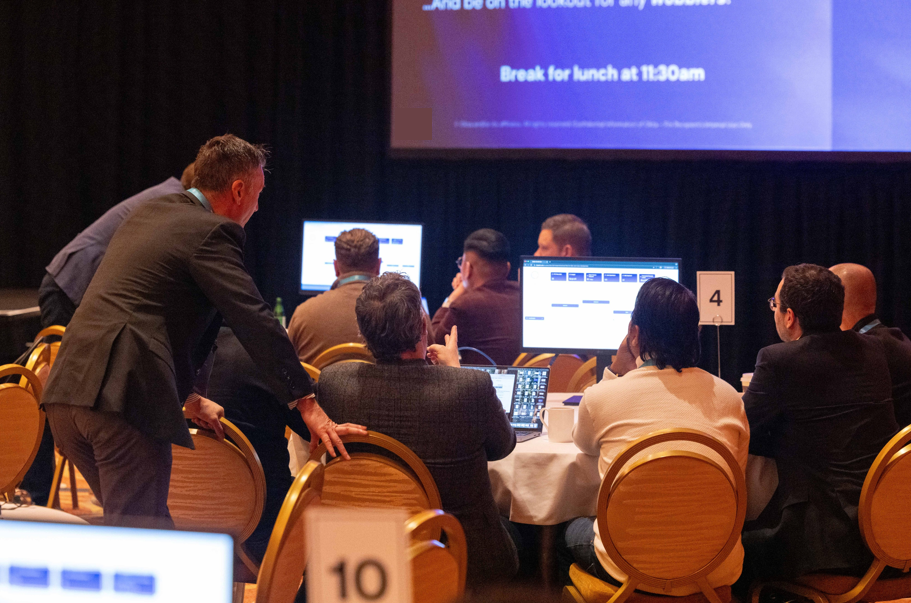Simulations Powering Leadership Development

Simulations for Leadership Development
Leadership Isn’t Learned in a Lecture
Leadership is not a job title. It’s a skill. And most orgs are promoting people into it without giving them a chance to practice.
Work gets more complex. Teams get more distributed. The stakes get higher. But the training? It’s still stuck in slide decks and group discussions that don’t translate when it’s 9 a.m. Monday and there’s a real issue on the table.
That’s where simulations come in.
If you're serious about building confident, capable leaders, whether they’re first-time managers or rising execs, you need to move past concepts and into practice.
What Is a Leadership Simulation?
A leadership simulation is an interactive experience that puts people into the real moments leaders face, before they’re in those moments live.
You don’t just talk about giving feedback, handling conflict, or making a strategic decision. You do it. In context. Under pressure. With consequences.
It’s not theoretical. It’s applied. And that’s why it works.
Simulations are designed to replicate your environment, your team dynamics, and your challenges. Some are fast reps. Others are immersive experiences. Either way, they put people in the deep end, without the risk of letting them drown.
Why Leadership Simulations Work
Leadership Requires Judgment, Not Just Knowledge
You can memorize frameworks all day. But when the team is tense, the stakes are high, and there’s no clear right answer, you need leaders who can think, adapt, and act with confidence. Simulations build that kind of muscle.
Safe Pressure
Simulations create high-pressure situations without the real-world consequences. It’s where people learn to lead through hard moments, not just talk about them.
Feedback With Teeth
Every decision, every move, every hesitation gets captured. That means managers, coaches, and HR leaders can spot gaps and build plans with signal, not guesswork.
Conversation-Ready, Not Just Concept-Ready
Many leadership moments are conversations: high stakes, emotionally charged, and tough to practice. That’s why Forge includes AI-powered conversational role-play for feedback, alignment, prioritization, and more.
Format Flexibility
Run a 15-minute simulation on how to lead a 1:1 or build a multi-session experience into a high-potential development program. Forge scales with you.
What Can You Simulate?

Leadership isn’t a job description. It’s a series of moments. Forge helps you simulate the ones that matter most.
Popular simulations include:
- Delivering tough feedback or addressing performance issues
- Leading through ambiguity, change, or crisis
- Managing up and aligning with execs
- Prioritizing tradeoffs under pressure
- Handling interpersonal conflict between team members
- Coaching direct reports through stretch opportunities
- Making strategic decisions with incomplete information
- Leading skip-level meetings or cross-functional initiatives
- Communicating a new vision or change in direction
Every simulation is designed to reflect your context, not a generic case study.
Who’s Using Leadership Simulations?
- L&D teams who need real readiness before promotion
- People managers who want to coach their future leaders
- HRBPs who support first-time managers or fast-scaling orgs
- Talent teams looking to de-risk leadership transitions
- Executives preparing their next layer of leaders
Whether you're rolling out a new manager program or developing VPs for broader scope, simulations create the practice field your leaders need.
The Forge Approach to Leadership Development
Forge gives you more than frameworks. We give your people space to lead — and tools to get better.
Here’s how:
- Role-specific simulations built around first-line managers, senior leaders, and execs
- Conversational AI for feedback, coaching, alignment, and conflict simulations
- Authoring tools so you can reflect your values, your org design, and your voice
- Experiences that range from 15-minute scenarios to multi-day programs
- Feedback workflows for self-reflection, peer coaching, and manager review
- Reporting that shows who’s ready, what they need, and how they lead under pressure
This isn’t training. It’s readiness.
FAQs About Leadership Simulations
What’s the difference between a simulation and a leadership workshop?
Workshops are great for awareness. Simulations build behavior. They don’t just talk about concepts. They let people practice using them — with feedback and pressure.
Can simulations help first-time managers?
Absolutely. Simulations are one of the fastest, safest ways to prepare someone for their first leadership role. They can practice tough conversations, prioritization, and people dynamics before they’re flying solo.
Can you simulate executive-level leadership?
Yes. Forge supports simulations for directors, VPs, and C-suite succession. From navigating board meetings to leading through crisis, we help high-level leaders build judgment in low-risk environments.
How do conversational role-plays work?
Our AI-driven simulations let people engage in real-time conversation with realistic feedback loops. Think coaching sessions, tough 1:1s, or stakeholder alignment — all tracked and structured.
How long does it take to launch a leadership simulation?
You can be live in days. Start with a proven scenario or build your own. Everything is customizable and repeatable.
Do simulations give me data I can use in development planning?
Yes. You’ll see how each person thinks, responds, and improves — which makes IDPs and promotion conversations real, not theoretical.
Leadership Is a Practice, Not a Theory
You wouldn’t let someone drive without hours behind the wheel. Why promote someone without reps in the seat?
If you want your leaders to thrive in the moments that matter, give them a place to practice. Simulations don’t replace learning. They unlock it.
Ready to Forge ahead?
Start building simulations that deliver momentum you can measure.





